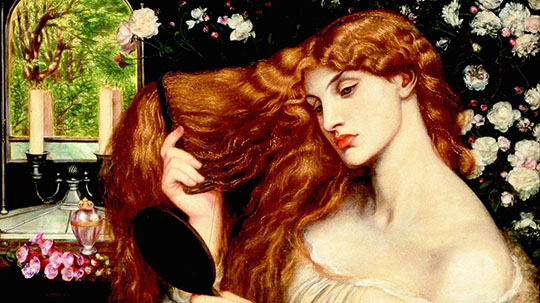 |
|||||||||||||
|
Obedience and Redemption Review "Obedience and Redemption". "In Jewish folklore, Alphabet of Sirach (c. 700–1000 CE) onwards, Lilith appears as Adam's first wife, who was created at the same time (Rosh Hashanah) and from the same clay as Adam—compare Genesis 1:27. (This contrasts with Eve, who was created from one of Adam's ribs: Genesis 2:22.) The legend developed extensively during the Middle Ages, in the tradition of Aggadah, the Zohar, and Jewish mysticism.[2] For example, in the 13th-century writings of Isaac ben Jacob ha-Cohen, Lilith left Adam after she refused to become subservient to him and then would not return to the Garden of Eden after she had coupled with the archangel Samael." ~ From Lilith on Wikipedia. Read more... Adam clutches a child in the presence of the child-snatcher, Lilith. By Filippino Lippi (1457-1504), Basilica of Santa Maria Novella. Public domain.  "Lady Lilith" by Dante Gabriel Rosetti. (Delaware Art Museum) "Lilith is the most notorious demon in Jewish tradition. In some sources, she is conceived of as the original woman, created even before Eve, and she is often presented as a thief of newborn infants. Lilith means “the night,” and she embodies the emotional and spiritual aspects of darkness: terror, sensuality, and unbridled freedom. More recently, she has come to represent the freedom of feminist women who no longer want to be “good girls.” ~ from Lilith, Lady Flying in Darkness, The most notorious demon of Jewish tradition becomes a feminist hero. by Rabbi Jill Hammer, My Jewish Learning. Read the entire article... "In the Renaissance, Michelangelo portrayed Lilith as a half-woman, half-serpent, coiled around the Tree of Knowledge. Later, her beauty would captivate the English poet Dante Gabriel Rossetti. “Her enchanted hair,” he wrote, “was the first gold.”1 Irish novelist James Joyce cast her as the “patron of abortions.”2 Modern feminists celebrate her bold struggle for independence from Adam. Her name appears as the title of a Jewish women’s magazine and a national literacy program. An annual music festival that donates its profits to battered women’s shelters and breast cancer research institutes is called the Lilith Fair. In most manifestations of her myth, Lilith represents chaos, seduction and ungodliness. Yet, in her every guise, Lilith has cast a spell on humankind. The ancient name “Lilith” derives from a Sumerian word for female demons or wind spirits—the lilītu and the related ardat lilǐ. The lilītu dwells in desert lands and open country spaces and is especially dangerous to pregnant women and infants. Her breasts are filled with poison, not milk. The ardat lilī is a sexually frustrated and infertile female who behaves aggressively toward young men. ~ from Lilith: Seductress, heroine or murderer? by Janet Howe Gaines, Bible History Daily, 03/15/2018. Read the entire article... |
| Copyright © Redefining the Sacred. All rights reserved. | |